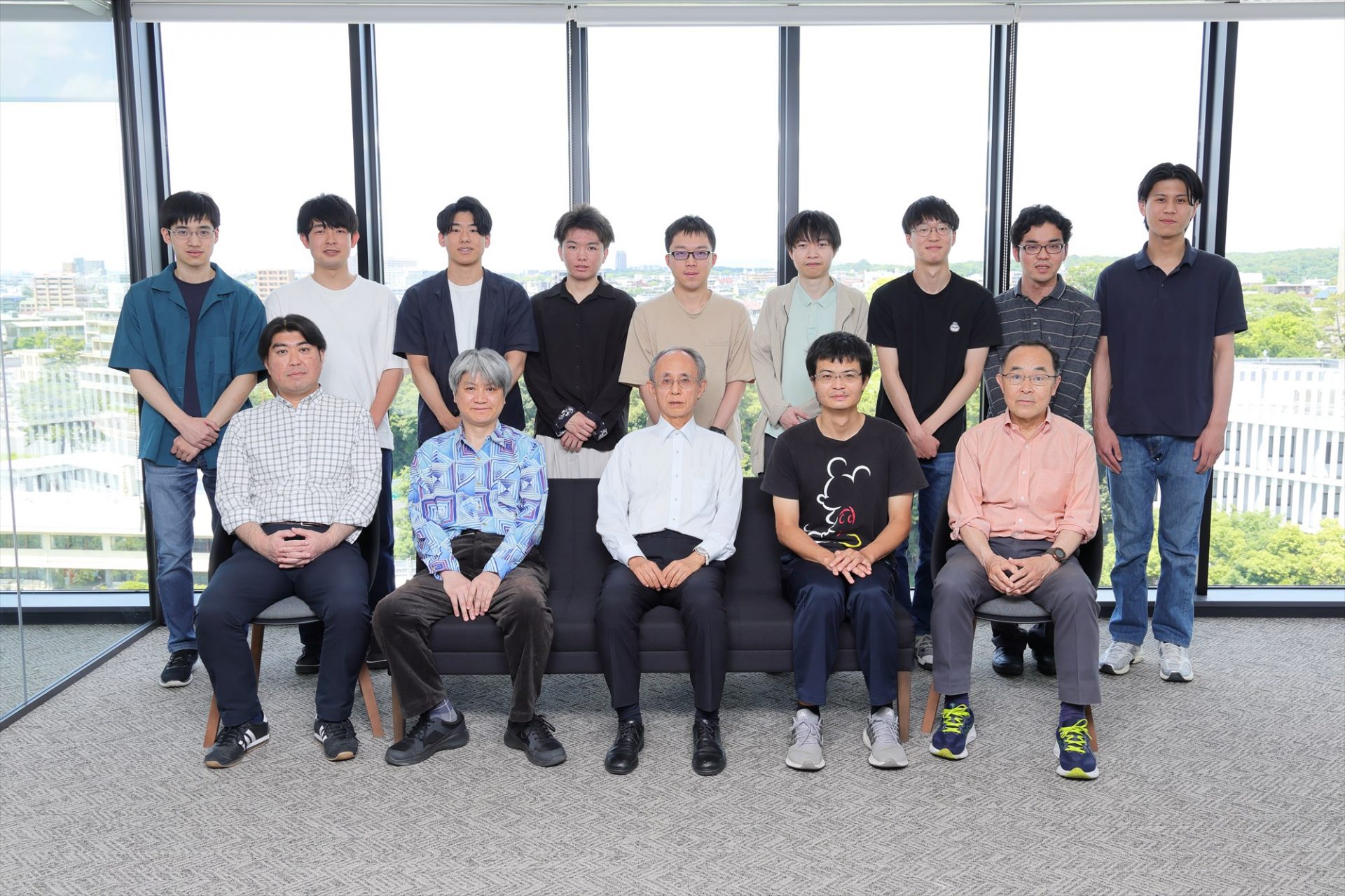| Predictions using computers based on principles of quantum mechanics |
▶Is research at the Shiraishi Laboratory conducted under a common theme?
Shiraishi: Although we share the common approach of “deriving insights using state-of-the-art computations”, each member works on a different theme. Some members occasionally collaborate on joint projects.
Within the Center for Integrated Research of Future Electronics (CIRFE; Director, Professor Hiroshi Amano), we focus on the mechanism of degradation and failure of gallium nitride (GaN) devices by constructing a computational model that closely simulates the experimental conditions. Moreover, we propose solutions to these problems. For example, we have theoretically suggested that oxygen vacancies at the GaN/oxide interface act as hole traps, and we found that adding magnesium can help eliminate them.
▶You issued a press release “unveiling the microscopic mechanism of vibration power generation devices”.
Shiraishi: I take pride in four major research achievements that have made significant contributions to society, and this achievement is one of them. The study of the microscopic mechanism of vibration power generation devices focused on a self-sustaining power generation device that utilizes silicon dioxide (SiO₂) to generate electricity from tiny vibrations. We clarified the mechanism behind the accumulation of negative charges using quantum mechanics and predicted the process that can enhance the reliability of devices. Our prediction was confirmed through experiments. The reliability of devices improved as expected. A company successfully commercialized the device in 2024.
For example, the device can be used to monitor cracks in highway bridges. The vibrations from passing vehicles generate sufficient power to support a small camera and lighting system, eliminating the need for battery replacements semipermanently. Other potential applications include the monitoring of the interior of water pipes.
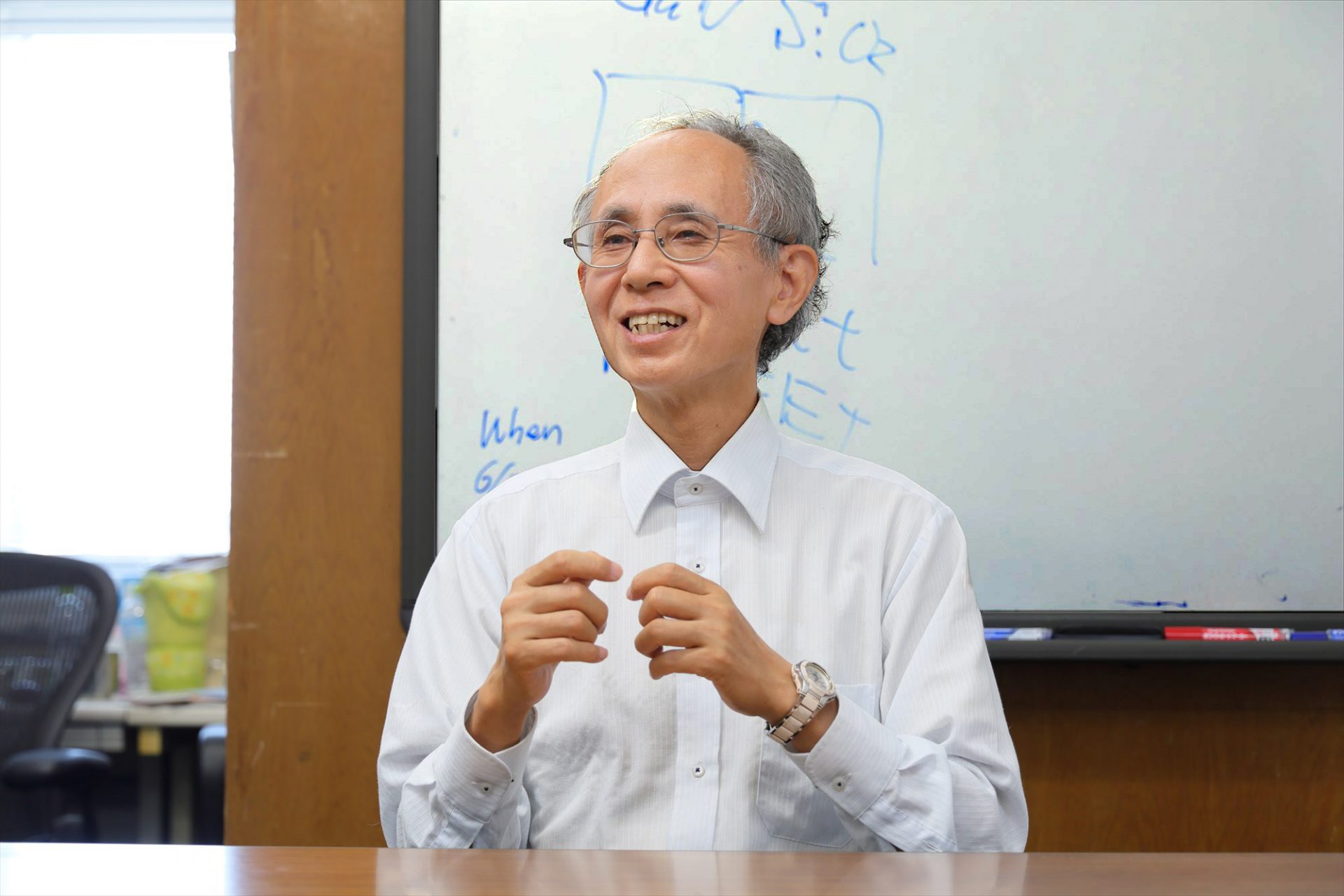
Professor Kenji Shiraishi
[profile]
March 1988: Completed his doctorate program in Physics at the Graduate School of Science, The University of Tokyo (Doctor of Science)
April 1988–December 2000: NTT Basic Research Laboratories
January 2001–September 2007: Assistant Professor, Graduate School of Pure and Applied Sciences, University of Tsukuba
October 2007–May 2013: Professor, Graduate School of Pure and Applied Sciences, University of Tsukuba
May 2013–September 2015: Professor, Graduate School of Engineering, Nagoya University
October 2013–present: Professor, Institute of Materials and Systems for Sustainability, Nagoya University
●Hobbies and Interests: Supporting SKE48
| From research to product development and mass production |
▶The device is a realization of a dream. Are there any other research achievements that have contributed to society?
Shiraishi: Yes. One example is flash memory, which is commonly used in USB storage devices. In recent years, flash memory using silicon nitride (SiN) has become widely used. Interestingly, the first SiN flash memory was used in automobiles in 2009. At the time, there was a concern that the threshold *1value might fluctuate, so we were asked to investigate the issue. After identifying the cause and publishing our findings in a research paper, automakers adopted our idea. SiN-based flash memory is now installed in automobiles worldwide. Since automobiles are associated with the risk of human lives, they must be supported by a solid, reliable theoretical foundation. Without that trust, no one would buy automobiles. However, once new devices used in automobiles are proven reliable, they become widely accepted. Today, the market scale for this technology has become immense, although my research paper has been cited only nine times (lol).
▶Did you originally aspire to be a researcher aiming for practical applications?
Shiraishi: For 13 years after graduating from university, I worked at NTT, where I was constantly told, “Work on something that will be useful 10 or 20 years from now”. I think that mindset became ingrained in me over time. At NTT, I conducted simulations of crystal growth, which involved modeling physical phenomena and performing virtual experiments on a computer. However, during my time there, I did not make any significant contributions to the industry. Eventually, Professor Oshiyama (introduced later), a senior from my university days, invited me to the University of Tsukuba as an assistant professor. I started getting involved in mass production applications, while also exploring fundamental scientific themes, such as the origins of life, which could only be pursued in a university.
▶What were you like as a child?
Shiraishi: When I was in kindergarten, I would spend all my time alone in a corner of the playground, just watching ants. I loved insects in general. I would let caterpillars crawl on my nose and even keep them as pets at home. Even in elementary school, I would get so absorbed in watching hairy caterpillars on my way to school. I was terrible at studying and my grades were consistently very low. I was once recommended for a special education class. The turning point came in junior high school when I solved a linear equation for the first time. Suddenly, everything made sense. I had always had a good memory, to the point where I could remember every insect in an illustration book. Once I grasped math, my grades in all other subjects improved as well.
▶What an amazing story! What message would you like to send to young people?
Shiraishi: I encourage young people to develop the ability to change perspectives depending on the research theme, while also being able to dig deep into the problem. Ideally, I want them to approach their work with a determination to change the world. I truly believe that if we do not do this, there will be no future for Japan. This applies not only to computational work but also to experimentation.
| Tackling one of the unsolved problems in classical physics: “The theory of turbulence” |
▶What kind of research is Dr. Yoshimatsu working on?
Yoshimatsu: My main focus is on the theory of turbulence. This is one of the unsolved problems in physics, and it is incredibly difficult, like exploring in a fog. So far, we don’t have a clear goal in sight.
The study of flow applies to both gases and liquids, which are of various kinds, both visible and invisible to the human eye. However, they are all treated as “fluids” in this context. My research involves calculating and developing a theoretical understanding of these fluids. Sometimes the flow is smooth, but vortices of various sizes can form when there are bumps or protrusions on the walls.
▶How do you tackle the incredibly complex movement (flow)?
Yoshimatsu: The fundamental equations for fluids are the Navier–Stokes equations (see Fig. 1). The equations are beautifully written. In theory, if you solve them, you can get the solutions. However, the equations are also well known for being extremely difficult to solve. During simulation, you see vortices of various sizes appearing all over the place. The differential equations containing partial derivatives of unknown functions unexpectedly induce complex behaviors, making the phenomenon incredibly complex. How to handle this is very troublesome.
 |
Figure 1: Navier–Stokes Equations
Legend: u, fluid velocity; ρ, fluid density; p, pressure; F, external force; ν, viscosity coefficient per unit density
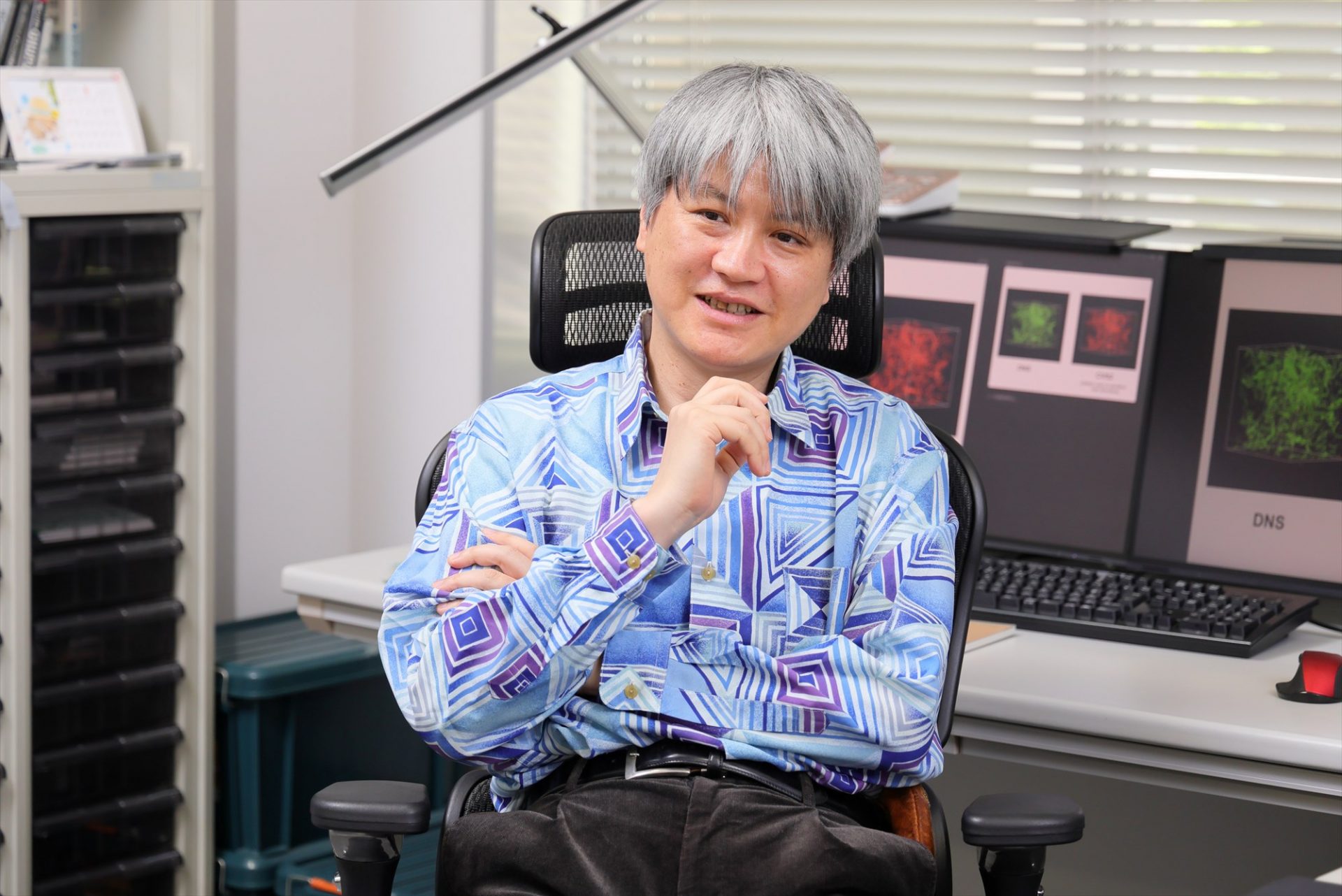
Associate Professor
Katsunori Yoshimatsu
[profile]
2001: Completed his doctorate program in Informatics at the Graduate School of Informatics, Kyoto University (Doctor in Informatics)
2004: Assistant professor at Nagoya University after working as a researcher at Nagoya University, Doshisha University, and Japan Science and Technology Agency (JST).
2014: Associate professor at Nagoya University.
●Hobbies and Interests: Gaming. He has been a fan of Hanshin Tigers since childhood. He also enjoys analog things.
▶Where are the predictions of “fluid” and “turbulence” used?
Yoshimatsu: Predictions of fluids and turbulence are used in many fields, including architecture, automobiles, machinery, environmental science, and even mathematics. For example, weather forecasting uses turbulence calculations. A specific application might be in determining the best design for an exhaust outlet to blow the gas as far as possible and whether to cut an exhaust outlet at a right angle or acute angle, namely, what shape would optimize the flow.
In the field of structural engineering, studies on vibrations caused by wind on structures have made a rapid advancement after the Tacoma Bridge※2 in Washington State (USA) collapsed in 1940. The 1.65-km-long bridge collapsed four months after its completion because of intense vibrations caused by large vortices formed downwind of the bridge’s girders.
▶What made you start working on “turbulence”
Yoshomatsu: I’ve always liked mathematics, and during my university years, my graduation research involved differential geometry. However, after the faculty advisor changed, I encountered fluid dynamics, which led me to turbulence. Turbulence is all about understanding complex phenomena and constructing its theory. In this process, it is crucial to determine whether certain possibilities exist or not. Mathematics is the only discipline capable of proving no possibility of existence and goes well with turbulence research.
▶What message would you like to send to young people?
Yoshimatsu: Currently, machine learning and AI are attracting great expectations. However, I believe that the ability to develop sound logic will still be important, even when AI takes the lead. Moreover, it is necessary to verify whether the results of simulations are correct or if the outcomes provided by AI are reasonable. This verification should be based on consistency with previous research and logical reasoning. I hope that young researchers value the fundamentals of mathematics and physics.
| Aiming for the creation of new two-dimensional materials |
▶You are primarily studying two-dimensional materials, ※3right?
Araidai: Yes, we are using computational simulations to predict the atomic structures and properties of two-dimensional materials. Two-dimensional materials are arranged in a sheet-like form with periodicity, making them extremely thin compared with three-dimensional crystals. There is a growing expectation for extremely thin two-dimensional materials because miniaturization and integration continue in semiconductor technology. In addition, it is suggested that new properties that do not exist in three-dimensional crystals might emerge. This has led to significant interest in two-dimensional materials from a fundamental science perspective. Among two-dimensional materials, we have been focusing on those composed of group 14 elements such as silicon, germanium, and tin. Young researchers have formed a team to continue research in this area.
▶Can you provide a brief introduction?
Araidai: Silicene and germanene, which are two-dimensional materials made from silicon and germanium, are theoretically predicted to have excellent electrical conductivity. Although they have been successfully synthesized on metal substrates, the excellent properties of these materials cannot be fully utilized on metal substrates. We have proposed a synthesis method for silicene and germanene to measure their unique properties. Currently, we are advancing this research under the Grant-in-Aid for Transformative Research Areas (B) with researchers in our university and other universities.
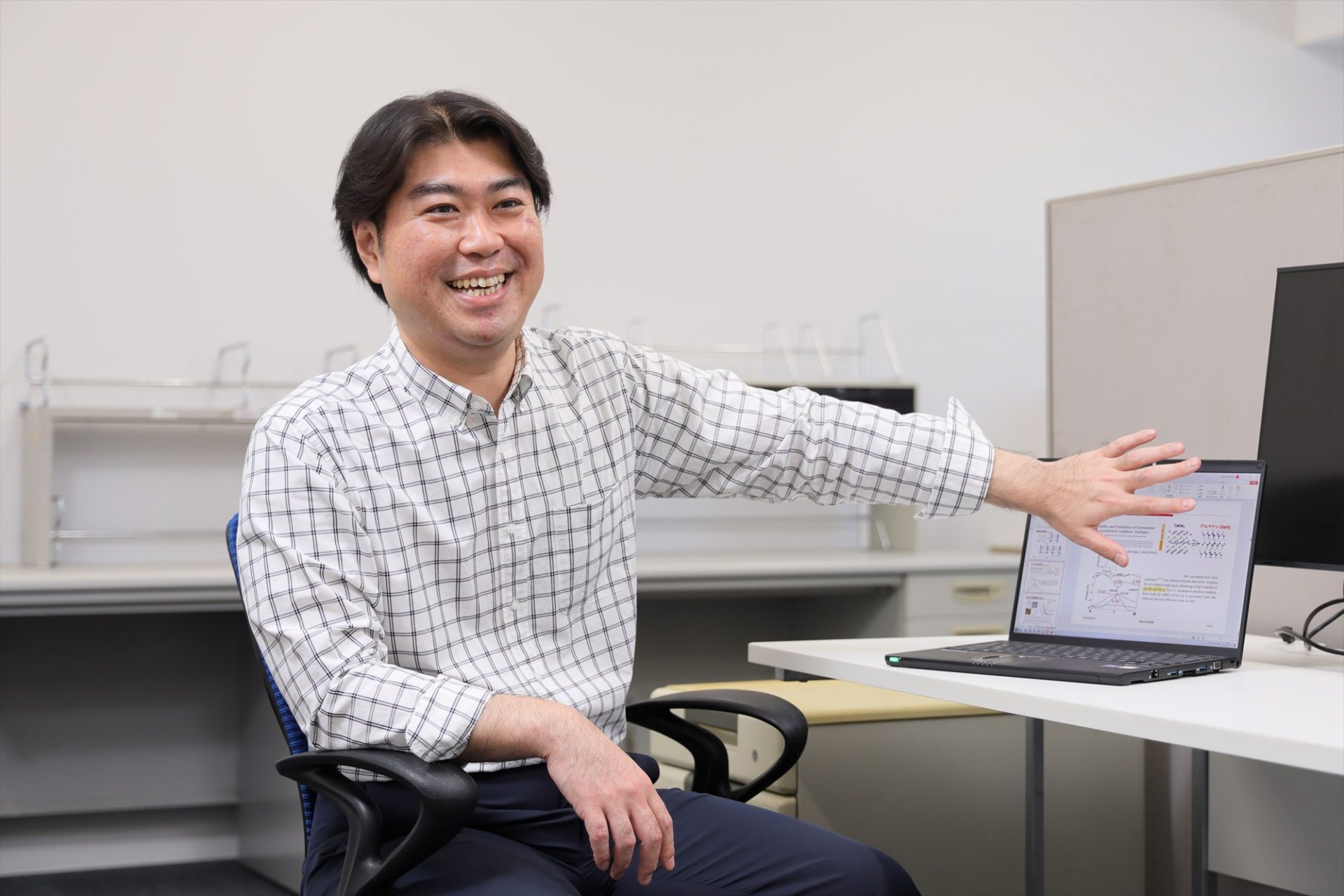
Assistant Professor
Masaaki Araidai
[profile]
2007: Completed his doctorate program in Science at the Graduate School of Science, Tokyo University of Science (Doctor in Science).
2013: Assistant professor at Nagoya University after working as a researcher at Waseda University, Tohoku University, and University of Tsukuba.
● Hobbies and Interests: Driving, billiards
| Naming the core of flash memory storage “floating state” |
▶Professor Oshiyama and Professor Shiraishi were from the same research laboratory during their student days, right?
Oshiyama: Yes, there’s a seven-year difference between us. When he was a university student, I had already obtained my doctorate and became an assistant. After that, I moved through positions at IBM (USA), NEC, and the University of Tsukuba, and eventually returned to The University of Tokyo. He was at NTT at that time. I invited him to join the University of Tsukuba because the position of assistant professor opened up. I must admit, I left without leaving a perfect impression (lol), so it was probably a bit tough for him at first. But that’s when our professional relationship started again.
▶You were invited to Nagoya by Professor Shiraishi?
Oshiyama: Yes, I retired from The University of Tokyo, but I was involved in the Program for Promoting Research on the Supercomputer Fugaku, supported by the Ministry of Education, Culture, Sports, Science, and Technology. So, I was looking for a place to continue my work, and that’s when I was invited to Nagoya University by Professor Shiraishi.
After arriving at Nagoya University, I worked on the calculation of epitaxial growth※4 of GaN, focusing on how atoms come together and grow during the process.
▶How has Fugaku been used in research?
Oshiyama: One example is flash memory.※5 It’s truly incredible. In flash memory, memory units are stacked three-dimensionally with 100 or even 200 layers, and electrons are captured and released within these layers. Surprisingly, the exact mechanism of how it functions as memory is still not fully understood, even though it’s widely used by everyone.
The material used in flash memory is amorphous SiN, which has spaces inside. I proposed that electrons are captured and stored to function as memory in these spaces and named this idea the “floating state”.
▶What message would you like to send to young people who will validate your proposal (prediction)?
Oshiyama: The concept of the floating state came from Mr. Matsushita, a student from my time as a professor at The University of Tokyo. He said, “I don’t understand why this happens”, although many accepted this phenomenon as a fact. He then conducted calculations and discovered the floating state. It is crucial to dig deep and think critically, persistently questioning and investigating during the research process.
Reflecting on my own experience, joy comes when the predicted results are obtained. However, true joy is found when the results that you predicted are not obtained but lead you to derive new predictions after analyzing why things turned out differently.
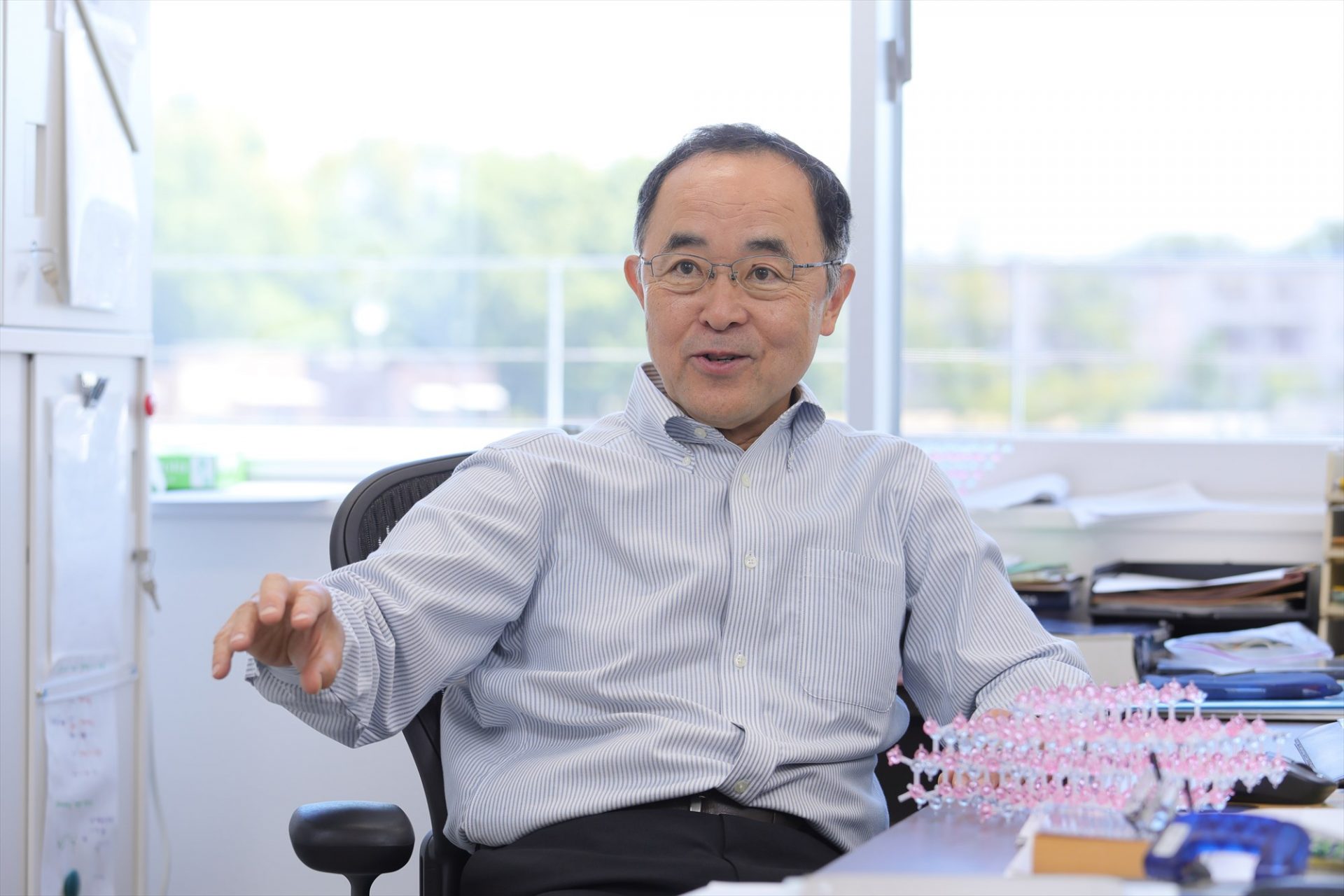
Designated Professor
Atsushi Oshiyama
[profile]
1981: Completed his doctorate program at The University of Tokyo (Doctor in Science) and became assistant at The University of Tokyo
1983: IBM Watson Research Center
1985: NEC Laboratories
1995: Professor in the Department of Physics, University of Tsukuba
2007: Professor in the Department of Applied Physics, The University of Tokyo
2018: Specially appointed professor, IMaSS, Nagoya University
●Hobbies and Interests: Drinking alcohol. Talking with small children. Playing soccer at Tsukuba until the age of 50 (now just watching). He played flute in the high school orchestra, but now cannot produce sound.
Glossary
※1 Threshold
The minimum physical intensity or stimulus required to induce sensations, reactions, or excitation. A boundary value. For example, in the context of performance monitoring, thresholds may be set for CPU usage, memory usage, and communication traffic volume to determine the normal/abnormal status of monitored servers on the basis of threshold values.(↑ Return to the text)
※2 Tacoma Bridge
Also known as the Tacoma Narrows Bridge. The bridge collapsed because of excessive vibrations caused by wind, which were captured in film by Dr. Farquharson and his group from the University of Washington. These detailed recordings became valuable technical assets.(↑ Return to the text)
※3 Two-Dimensional Materials
Materials with a thickness ranging from one to a few atoms (roughly 1 nm or less). Many two-dimensional materials are obtained by extracting a single layer from three-dimensional layered materials. A major characteristic of two-dimensional materials is that they can be “peeled” off. The development of two-dimensional materials is crucial for further miniaturizing semiconductor devices that have been based on three-dimensional materials represented by silicon.(↑ Return to the text)
※4 Epitaxial Growth
A thin-film crystallization technique used in semiconductor manufacturing where a new single-crystal thin film is grown on top of a semiconductor single-crystal substrate. The advantages of epitaxial growth include the ability to control the conductivity and resistance freely with the same or different material layers as the substrates and increased structural flexibility.(↑ Return to the text)
※5 Flash Memory
A type of nonvolatile memory that allows data to be written and read instantly, and retains the data even when the power is turned off. Common examples include USB storage devices and SD cards. It was developed by Fujio Masuoka at Toshiba in the 1980s.(↑ Return to the text)



